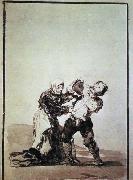
Oil On
Canvas, Real Flavor of Old Masters
|
Francisco de goya y Lucientes
|
|||
|
|
|||
| b. March 30, 1746, Fuendetodos, Spain--d. April 16, 1828, Goya is considered the 18th Century's foremost painter and etcher of Spanish culture, known for his realistic scenes of battles, bullfights and human corruption. Goya lived during a time of upheaval in Spain that included war with France, the Inquisition, the rule of Napoleon's brother, Joseph, as the King of Spain and, finally, the reign of the Spanish King Ferdinand VII. Experts proclaim these events -- and Goya's deafness as a result of an illness in 1793 -- as central to understanding Goya's work, which frequently depicts human misery in a satiric and sometimes nightmarish fashion. From the 1770s he was a royal court painter for Charles III and Charles IV, and when Bonaparte took the throne in 1809, Goya swore fealty to the new king. When the crown was restored to Spain's Ferdinand VII (1814), Goya, in spite of his earlier allegiance to the French king, was reinstated as royal painter. After 1824 he lived in self-imposed exile in Bordeaux until his death, reportedly because of political differences with Ferdinand. Over his long career he created hundreds of paintings, etchings, and lithographs, among them Maya Clothed and Maya Nude (1798-1800); Caprichos (1799-82); The Second of May 1808 and The Third of May 1808 (1814); Disasters of War (1810-20); and The Black Paintings (1820-23). | |||
|
|
|||
|
|
You'll see later new21/Francisco de goya y Lucientes-678532.jpg Painting ID:: 62480 Visit European Gallery |
1803-12 Indian ink and pen on pink paper, 266 x 187 mm Metropolitan Museum of Art, New York This sketch shows a burly lower-class man drinking greedily from a leather bottle. Ha has clearly been arguing with his wife, and Goya shows a moment of discord and dramatic action. With just a few precise brushstrokes and without any prior drawing, Goya conveys an emotionally charged expression. Author: GOYA Y LUCIENTES, Francisco de Title: You'll see later (Despu?s lo veras) Form: graphics , 1801-1850 , Spanish , study | |
Height Width |
INS/CM |
||







